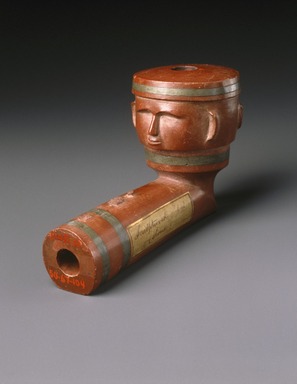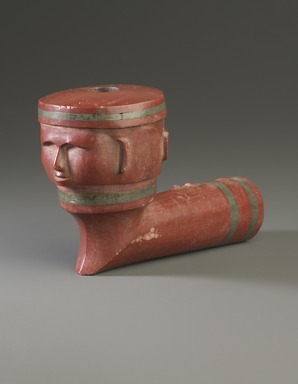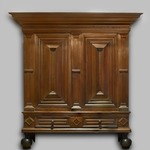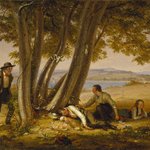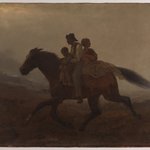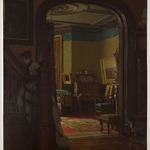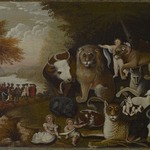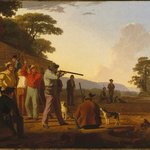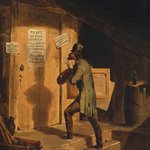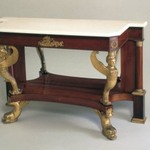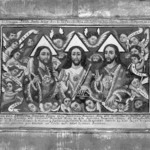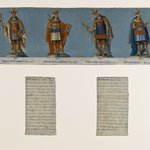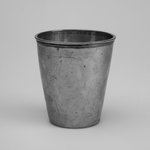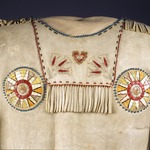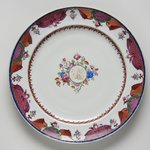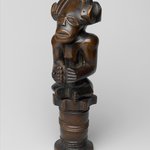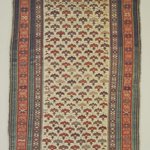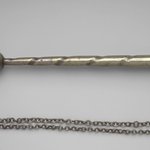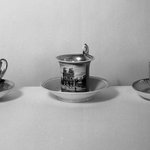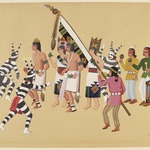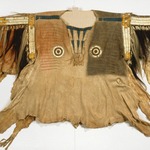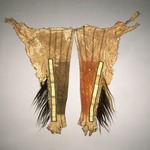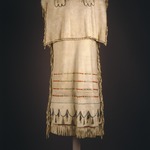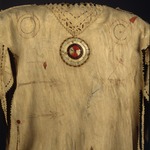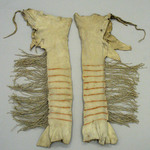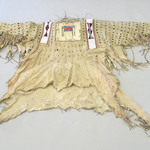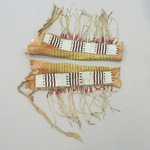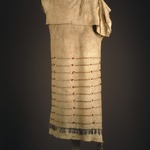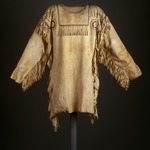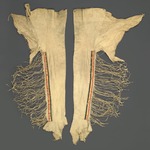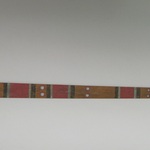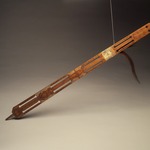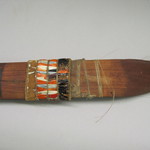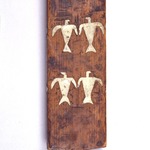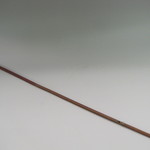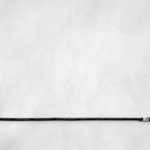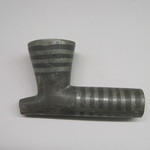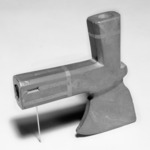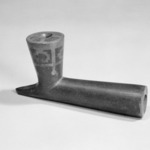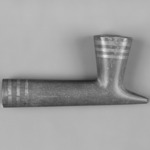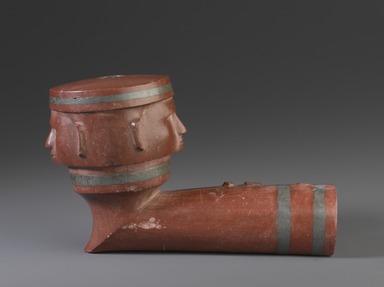

Sisseton, Sioux. Inlaid Pipe Bowl with Two Faces, early 19th century. Catlinite (pipestone), lead, 3 x 5 x 3 in. (7.6 x 12.7 x 7.6 cm). Brooklyn Museum, Henry L. Batterman Fund and the Frank Sherman Benson Fund, 50.67.104. Creative Commons-BY (Photo: Brooklyn Museum, 50.67.104_profile_PS9.jpg)
Inlaid Pipe Bowl with Two Faces
Arts of the Americas
The Jarvis Collection of Native American Plains Art
The articles in this case and the adjacent clothing case are some of the earliest and finest Eastern Plains pieces in existence. They were collected by Dr. Nathan Sturges Jarvis, a military surgeon stationed at Fort Snelling, Minnesota, between 1833 and 1836. He purchased some of the objects, while some may have been given in exchange for his medical services. These works display indigenous people’s ingenuity in combining trade materials such as cloth, metal, and glass beads with traditional hides, red pipestone, and porcupine and bird quills.
The articles in this case and the adjacent clothing case are some of the earliest and finest Eastern Plains pieces in existence. They were collected by Dr. Nathan Sturges Jarvis, a military surgeon stationed at Fort Snelling, Minnesota, between 1833 and 1836. He purchased some of the objects, while some may have been given in exchange for his medical services. These works display indigenous people’s ingenuity in combining trade materials such as cloth, metal, and glass beads with traditional hides, red pipestone, and porcupine and bird quills.
CULTURE
Sisseton, Sioux
MEDIUM
Catlinite (pipestone), lead
DATES
early 19th century
DIMENSIONS
3 x 5 x 3 in. (7.6 x 12.7 x 7.6 cm) (show scale)



INSCRIPTIONS
"Ornamented War Chief's Pipe (Sisseton Sioux)"
COLLECTIONS
Arts of the Americas
ACCESSION NUMBER
50.67.104
CREDIT LINE
Henry L. Batterman Fund and the Frank Sherman Benson Fund
PROVENANCE
Prior to 1848, provenance not yet documented; by 1848, acquired by Nathan Sturges Jarvis; 1848, gift of Nathan Sturges Jarvis to the New-York Historical Society, New York, NY; 1937, loaned by the New-York Historical Society to the Brooklyn Museum; 1950, purchased from the New-York Historical Society by the Brooklyn Museum.
Provenance FAQ
CATALOGUE DESCRIPTION
Red catlinite pipe. The bowl is carved with two human faces; one placed facing the smoker and the other at the back of the bowl. Bands of lead are inlaid around the bowl and the short section meant to connect to the stem. There are remnants of where another figure was attached to the topside of the short stem.
EXHIBITIONS
MUSEUM LOCATION
This item is not on view
CAPTION
Sisseton, Sioux. Inlaid Pipe Bowl with Two Faces, early 19th century. Catlinite (pipestone), lead, 3 x 5 x 3 in. (7.6 x 12.7 x 7.6 cm). Brooklyn Museum, Henry L. Batterman Fund and the Frank Sherman Benson Fund, 50.67.104. Creative Commons-BY (Photo: Brooklyn Museum, 50.67.104_profile_PS9.jpg)
IMAGE
profile, 50.67.104_profile_PS9.jpg. Brooklyn Museum photograph, 2013
"CUR" at the beginning of an image file name means that the image was created by a curatorial staff member. These study images may be digital point-and-shoot photographs, when we don\'t yet have high-quality studio photography, or they may be scans of older negatives, slides, or photographic prints, providing historical documentation of the object.
RIGHTS STATEMENT
Creative Commons-BY
You may download and use Brooklyn Museum images of this three-dimensional work in accordance with a Creative Commons license. Fair use, as understood under the United States Copyright Act, may also apply.
Please include caption information from this page and credit the Brooklyn Museum. If you need a high resolution file, please fill out our online application form (charges apply).
For further information about copyright, we recommend resources at the United States Library of Congress, Cornell University, Copyright and Cultural Institutions: Guidelines for U.S. Libraries, Archives, and Museums, and Copyright Watch.
For more information about the Museum's rights project, including how rights types are assigned, please see our blog posts on copyright.
If you have any information regarding this work and rights to it, please contact copyright@brooklynmuseum.org.
RECORD COMPLETENESS
Not every record you will find here is complete. More information is available for some works than for others, and some entries have been updated more recently. Records are frequently reviewed and revised, and we welcome any additional information you might have.
